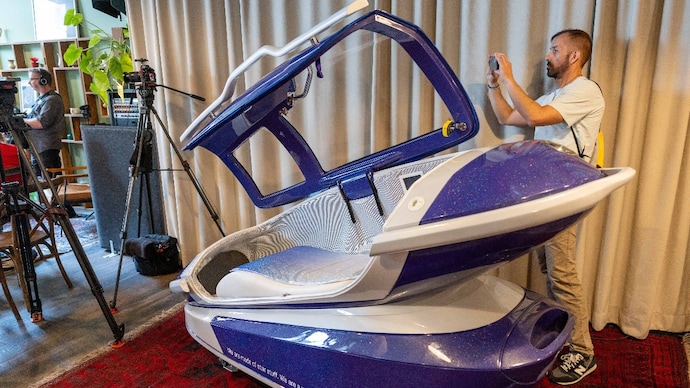The futuristic-looking capsule has sparked a global debate on ethics after an American woman became the first person to use the pod to end her life.

The Sarco suicide machine during a presentation in Zurich (Reuters)
"If you want to die, press this button," a voice reads out the chilling eight-word message as a user enters the controversial Sarco 'suicide pod'. The futuristic-looking capsule has sparked a global debate on ethics after an American woman, suffering from an autoimmune condition, became the first person to use the pod to end her life.
Several people have been arrested on suspicion of inciting, aiding and abetting suicide after the 64-year-old woman died on Monday. The portable, 3D-printed pod -- dubbed the 'Tesla of euthanasia' -- was set up in a forest near the Swiss-German border as the woman wanted to see the "trees and sky above her" before she died, according to a Daily Mail report.
Trigger warning: The following text contains distressing content
The brain behind the capsule is Australian doctor Philip Nitschke, nicknamed Doctor Death, who devised the pod to help the terminally sick end their lives. However, Dr Nitschke's career has been marred by clashes with Australian authorities over his beliefs and his medical licence was even suspended in 2014.
"She lost consciousness within two minutes, and she died after five minutes," Dr Nitschke, who also heads the euthanasia campaign Exit , told Dutch media.
So, how does the 'suicide pod' work?
After entering the machine, the user hears a voice saying, "If you want to die, press this button." For the specially abled who may not be able to press the button, the process can also be activated through eye movement and voice control.
However, once the process is activated by the user, there is no way to stop or reverse it.
Usually, the air we breathe contains 21 per cent oxygen and 79 per cent nitrogen. Inside the pod, the air is replaced with 100 per cent nitrogen.
Once the button is pressed inside the pod, the oxygen plummets from 21 per cent to 0.05 percent in less than 30 seconds. This renders the user unconscious and stops the breathing process in less than ten minutes.
The final moments of the user are recorded on a camera placed inside the pod and the footage is then handed to a coroner.
Why has the 'suicide pod' sparked a controversy?
The device and the process have generated widespread debate on social media, with critics underscoring that the pod's design glamorises suicide. Experts have also flagged that the fact the pod could be operated without medical oversight was concerning.
However, advocates of the device said it expanded access to euthanasia and called it a viable option since it was not reliant on drugs or doctors.
The present controversy hinges on the fact that the device was used despite not being approved by Swiss authorities. Authorities have previously warned that those operating the suicide pod could face criminal proceedings, including a five-year jail term.
This even as Switzerland is one of the few nations where people can travel to legally end their lives through assisted suicide.
Published By:
Abhishek De
Published On:
Sep 26, 2024

 1 month ago
1 month ago














